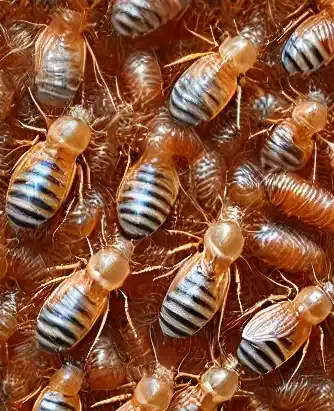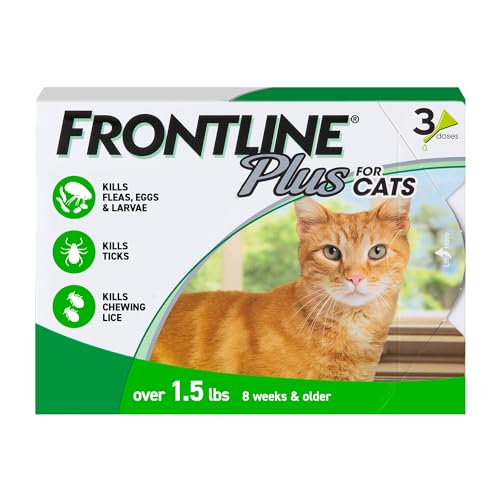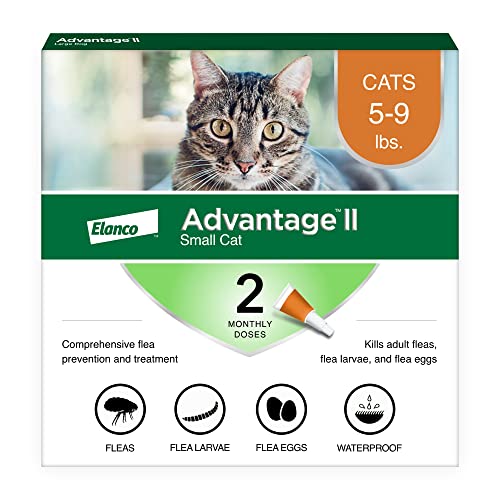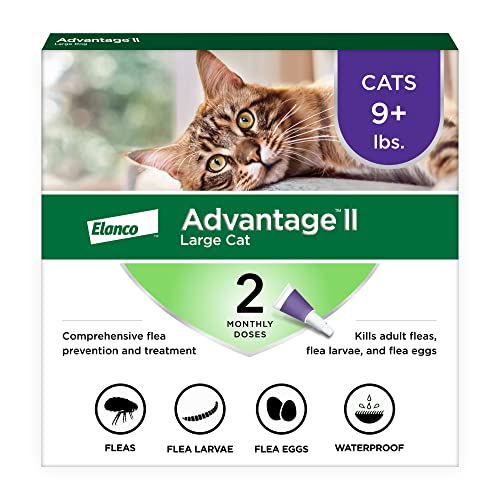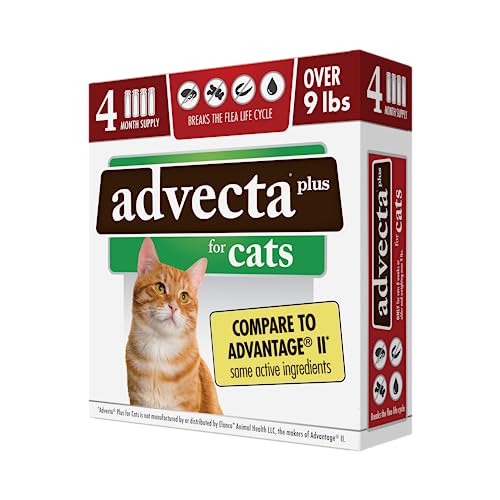There's no denying the sinking feeling that accompanies the discovery of fleas on your beloved feline companion. The incessant scratching, the telltale "flea dirt" peppering their fur, and the sight of those tiny, dark insects darting through their coat – it's enough to make any cat owner's heart sink. But fear not, for swift action can quickly turn the tide against these tenacious pests. Your goal is to learn how to get rid of fleas on cats fast!
Fleas are more than just a nuisance; they can wreak havoc on your cat's health and well-being. Their bites cause intense itching and irritation, leading to excessive scratching, hair loss, and even skin infections. In severe cases, fleas can transmit diseases and parasites, further compromising your cat's health.
The good news is that you have a multitude of options at your disposal to get rid of fleas on cats fast. From powerful veterinary-prescribed medications to natural home remedies and preventive measures, there's a solution for every cat and every situation.
If you're looking for a rapid knockdown effect, spot-on treatments like Advantage II or Frontline Plus can quickly eliminate adult fleas on contact and hence get rid of cat fleas fast. These topical solutions are easy to apply and offer fast-acting relief for your itchy feline friend. For a more comprehensive approach, oral medications like Capstar can kill adult fleas within hours, while longer-lasting options like Comfortis and Bravecto disrupt the flea life cycle, preventing future generations from taking hold.
If you prefer a more natural approach, flea combs are an effective tool for physically removing fleas and their eggs from your cat's fur. A soothing bath with a gentle flea shampoo or diluted Dawn dish soap can also provide relief and help eliminate adult fleas.
The battle against fleas doesn't end with your cat. Their eggs can infest your home, lurking in carpets, bedding, and furniture. Regular vacuuming, laundering, and even the strategic use of pet-safe insecticides can help you eradicate these hidden threats and create a flea-free environment.
Prevention is key to long-term flea control. Monthly preventatives, such as topical treatments, oral medications, or collars, can provide continuous protection for your cat, ensuring that fleas don't stand a chance.
Remember, the faster you act, the sooner your cat will be back to their happy, healthy self. With the right knowledge, tools, and a proactive approach, you can swiftly reclaim your home from these unwelcome guests and give your feline friend the flea-free life they deserve. Remember, the key to how to get rid of fleas on cats fast is attacking the problem early!
Understanding the Flea Problem on Your Cat
As a cat owner, discovering fleas on your beloved feline friend can be a distressing experience. These tiny, agile parasites can quickly turn your cuddly companion into an itchy, uncomfortable mess. But fear not, understanding the flea problem is the first step towards effective eradication and prevention.
Fleas and Your Cat's Health
Fleas are more than just a nuisance; they pose a significant threat to your cat's health and well-being. These parasites survive by feeding on your cat's blood, which can lead to a range of health issues. The most immediate problem is the intense itching and irritation caused by flea bites. Excessive scratching can damage your cat's skin, leading to hair loss, scabs, and secondary infections.
In severe cases, fleas can cause anemia in cats, especially in kittens or older cats. Anemia is a condition where the red blood cell count is low, resulting in weakness, lethargy, and pale gums. Moreover, fleas can also transmit tapeworms and other parasites to your cat, further compromising their health.
The Flea Life Cycle: Understanding the Enemy
Understanding the flea life cycle is crucial for effective flea control. Fleas undergo four distinct stages: egg, larva, pupa, and adult. Adult fleas lay eggs on your cat, which then fall off into the environment, such as your carpets, bedding, and furniture. These eggs hatch into larvae, which feed on organic debris and flea dirt (flea feces). The larvae then spin cocoons and enter the pupa stage, where they develop into adult fleas.
The entire life cycle can take as little as two weeks under ideal conditions, meaning a few fleas on your cat can quickly escalate into a full-blown infestation in your home. The pupa stage is particularly challenging to eradicate, as pupae are resistant to many insecticides and can remain dormant for extended periods until environmental conditions are favorable for their emergence as adult fleas.
Signs of a Flea Infestation on Your Cat
Detecting fleas on your cat early on is crucial for swift and effective treatment. Here are some common signs of a flea infestation:
Excessive Scratching: If your cat is constantly scratching, biting, or licking their fur, it could be a sign of fleas.
Flea Dirt: Flea dirt, which is essentially flea feces, looks like tiny black specks that resemble ground pepper. You can find flea dirt by combing your cat's fur with a fine-toothed flea comb.
Visible Fleas: In severe infestations, you may be able to see adult fleas crawling on your cat's fur. They are small, dark brown insects that move quickly and can jump long distances.
Hair Loss: Excessive scratching due to flea bites can lead to hair loss, especially around the neck, base of the tail, and belly.
Skin Irritation: Flea bites can cause red, inflamed bumps on your cat's skin, leading to further itching and discomfort.
If you notice any of these signs, it's important to take action immediately to get rid of fleas on your cat and prevent the infestation from spreading.
How to Get Rid of Fleas on Cats Fast - Veterinary Intervention
While home remedies and over-the-counter products can offer some relief, the most effective and rapid way to get rid of fleas on cats is through veterinary intervention. Your veterinarian is equipped with a wealth of knowledge and a range of powerful flea treatments that are not readily available to the general public. They can tailor a treatment plan to your cat's specific needs, ensuring a safe and efficient resolution to the flea infestation.
The Importance of a Vet Visit
A visit to your veterinarian is crucial for several reasons:
Accurate Diagnosis: Your vet can confirm the presence of fleas and assess the severity of the infestation. They can also rule out other potential causes of your cat's discomfort, such as allergies or skin infections.
Personalized Treatment Plan: Your vet will consider your cat's age, weight, health status, and lifestyle to recommend the most appropriate flea treatment options. This personalized approach ensures the safety and effectiveness of the chosen treatment.
Professional Guidance: Your vet can provide valuable advice on how to use flea treatments safely and effectively, as well as tips for preventing future infestations.
Spot-On Treatments (Topical): A Swift and Targeted Strike
Spot-on treatments are among the most popular and effective flea treatments for cats. They are applied directly to your cat's skin, usually between the shoulder blades, where they cannot lick it off. These topical solutions work quickly to kill adult fleas and often provide residual protection for several weeks.
How They Work: Spot-on treatments typically contain powerful insecticides like imidacloprid, fipronil, or selamectin. These chemicals are absorbed through your cat's skin and distributed throughout their body, killing fleas on contact.
Common Brands: Popular spot-on treatments for cats include Advantage II, Frontline Plus, Revolution, and Bravecto. Each brand may contain different active ingredients and offer varying durations of protection.
Pros and Cons: Spot-on treatments are generally easy to apply, fast-acting, and effective against adult fleas. However, they may not be suitable for all cats, especially those with sensitive skin or allergies. Some cats may experience mild side effects like skin irritation or hair loss at the application site. Always consult your veterinarian to determine the best spot-on treatment for your cat.
Oral Medications: Disrupting the Flea Life Cycle
Oral flea medications are another effective option for treating and preventing fleas on cats. They are administered by mouth, either as a pill or a chewable tablet, and work by disrupting the flea life cycle at various stages.
Fast-Acting Options (Capstar): Capstar is a popular oral medication that contains nitenpyram, an ingredient that quickly kills adult fleas within hours of administration. It is often used as a first-line treatment to provide immediate relief from flea bites and reduce the adult flea population on your cat. However, Capstar does not provide long-term protection and should be used in conjunction with other flea preventatives for ongoing control.
Longer-Term Options (Comfortis, Bravecto): Comfortis and Bravecto are chewable tablets that provide longer-lasting flea protection. Comfortis contains spinosad, while Bravecto contains fluralaner. Both of these active ingredients work by disrupting the flea life cycle, preventing eggs from hatching and larvae from developing into adults. This effectively breaks the cycle of infestation and provides ongoing protection for your cat.
When to Choose Oral Medications: Oral medications are a good option for cats that are difficult to handle for topical treatments or those that have sensitive skin. They are also beneficial for multi-pet households, as they can help prevent the spread of fleas between animals. However, it's important to consult your veterinarian to determine the appropriate oral medication for your cat's specific needs.
Injections: Long-Lasting Protection for Severe Cases
In certain situations, your veterinarian may recommend an injectable flea treatment. These injections typically provide long-lasting protection for several months and are often used for cats with severe infestations or those that are difficult to treat with topical or oral medications.
How They Work: Injectable flea treatments contain an active ingredient called lufenuron, which is a type of insect growth regulator (IGR). Lufenuron works by preventing flea eggs from hatching and larvae from developing into adults, effectively breaking the flea life cycle. It does not kill adult fleas, so it is often used in conjunction with other flea treatments that target adult fleas.
Vet Supervision: Injectable flea treatments are administered by your veterinarian and require periodic re-administration to maintain their effectiveness. Your vet will determine the appropriate dosage and frequency of injections based on your cat's individual needs and the severity of the infestation.
By working closely with your veterinarian and utilizing the most appropriate flea treatment options, you can quickly and effectively get rid of fleas on your cat and prevent future infestations. Remember, prompt intervention is key to protecting your feline friend's health and well-being.
Mechanical Removal: Swift and Drug-Free Flea Elimination for Your Cat
While veterinary interventions play a crucial role in combating flea infestations, there are several non-chemical, mechanical methods you can employ to get rid of fleas on cats quickly and without the need for medications. These methods can be used in conjunction with veterinary treatments or as standalone solutions for mild infestations.
Flea Combs: Your First Line of Defense
Flea combs are essential tools in your flea-fighting arsenal. They are specially designed with fine teeth that can effectively trap and remove adult fleas, flea eggs, and flea dirt (flea feces) from your cat's fur. Regular combing with a flea comb not only provides immediate relief for your cat but also helps to monitor the severity of the infestation.
Choosing the Right Flea Comb: Opt for a fine-toothed metal comb specifically designed for flea removal. Avoid plastic combs, as their teeth may be too widely spaced to effectively catch fleas.
Combing Technique: Start by gently combing your cat's fur in the direction of hair growth. Pay special attention to areas where fleas tend to congregate, such as the neck, base of the tail, and belly. Use short, gentle strokes to avoid irritating your cat's skin.
The "Soapy Water Dip": After each pass with the comb, dip it into a bowl of warm, soapy water. The soap will trap and drown any fleas or eggs that have been removed from your cat's fur. Be sure to empty and refill the soapy water frequently to maintain its effectiveness.
Frequency of Combing: For active infestations, aim to comb your cat at least once or twice a day. As the infestation subsides, you can gradually reduce the frequency of combing. However, continue to comb your cat regularly, even after the infestation is under control, to detect any new fleas early on.
Flea Baths: A Soothing and Cleansing Solution
Bathing your cat with a flea shampoo or diluted Dawn dish soap can be an effective way to remove adult fleas and soothe their irritated skin. However, it's important to use the right products and techniques to ensure a safe and successful bath time experience.
Flea Shampoo vs. Dawn Dish Soap: Flea shampoos are specifically formulated to kill fleas and soothe irritated skin. They typically contain gentle insecticides like pyrethrin or permethrin, which are safe for cats when used as directed. If you don't have flea shampoo on hand, diluted Dawn dish soap can be an effective alternative. Dawn is known for its grease-cutting properties, which can help to break down the flea's exoskeleton and drown them. However, it's important to dilute Dawn with water (typically a ratio of 1:10) to avoid irritating your cat's skin.
Proper Bathing Technique: Before bathing your cat, gather all necessary supplies, including shampoo, towels, and a container of warm water. Start by thoroughly wetting your cat's fur with lukewarm water. Apply the shampoo or diluted Dawn dish soap and lather it into their fur, working from head to tail. Be sure to avoid getting any soap in their eyes, ears, or mouth. Allow the shampoo to sit on your cat's fur for the recommended amount of time (usually 5-10 minutes), then rinse thoroughly with warm water. After the bath, dry your cat with a towel and keep them warm until they are completely dry.
Post-Bath Precautions: After the bath, be sure to thoroughly clean the bathing area to remove any fleas or flea eggs that may have been dislodged. Wash all towels and any other fabrics that came into contact with your cat in hot water to kill any remaining fleas.
By combining mechanical removal methods like flea combing and bathing with veterinary treatments, you can quickly and effectively get rid of fleas on your cat and provide them with much-needed relief from the discomfort and irritation caused by these pesky parasites.
Home Environment Assault: Eradicating Fleas from Your Living Space
While treating your cat is a critical first step, a comprehensive flea control strategy also involves tackling the infestation within your home. Fleas are notorious for their ability to spread rapidly, laying eggs in carpets, bedding, furniture, and even the cracks and crevices of your floors. If left unchecked, these eggs can hatch and perpetuate the infestation, making it difficult to get rid of fleas on cats completely. Therefore, a multi-pronged approach is necessary to eliminate fleas from your living environment and create a safe haven for your feline companion.
Vacuum Warfare: Your Most Potent Weapon
Your trusty vacuum cleaner is a powerful ally in the battle against fleas. Regular and thorough vacuuming is essential for removing adult fleas, eggs, larvae, and pupae from your home. By diligently vacuuming all areas where your cat spends time, you can significantly reduce the flea population and disrupt their life cycle.
Frequency of Vacuuming: During an active flea infestation, it's crucial to vacuum your home daily, paying special attention to areas where your cat sleeps, rests, or plays. This includes carpets, rugs, upholstery, and even hardwood floors. Once the infestation is under control, you can reduce the frequency of vacuuming to once or twice a week as a preventive measure.
Targeted Vacuuming: Focus your vacuuming efforts on areas where fleas are most likely to be found. These include:
Carpets and Rugs: Fleas and their eggs can burrow deep into carpet fibers, making thorough vacuuming essential. Be sure to vacuum under furniture and along baseboards, where fleas may hide.
Upholstery: Fleas can also infest upholstered furniture, so vacuum all cushions, crevices, and seams.
Pet Bedding: Wash your cat's bedding in hot water and dry it on high heat. Vacuum the area where the bed is located to remove any remaining fleas or eggs.
Floors: Even hardwood floors can harbor fleas and their eggs, so vacuuming is still necessary. Pay attention to cracks and crevices, where fleas may hide.
Emptying the Vacuum: After each vacuuming session, it's crucial to empty the vacuum bag or canister outdoors to prevent re-infestation. Fleas can survive inside the vacuum and potentially escape back into your home. If you have a bagless vacuum, dispose of the debris in a sealed plastic bag and discard it in an outdoor trash bin.
Laundry Offensive: Eliminating Fleas from Fabrics
Fleas can also infest fabrics, such as bedding, blankets, and clothing. To ensure complete eradication, it's important to wash all fabrics that your cat has come into contact with in hot water.
Hot Water Wash: Launder all bedding, blankets, cat beds, and any other fabrics your cat touches in hot water (at least 140°F) to kill fleas and their eggs. Add detergent and a small amount of bleach (if safe for the fabric) for extra cleaning power.
High Heat Drying: After washing, dry all fabrics on the highest heat setting your dryer allows. This will further ensure that any remaining fleas or eggs are eliminated.
Non-Washable Fabrics: For items that cannot be washed, such as delicate fabrics or large rugs, consider professional cleaning or steam cleaning to kill fleas and their eggs.
Chemical Intervention (Optional): A Last Resort
In severe or persistent flea infestations, chemical intervention may be necessary to eradicate fleas from your home. However, it's important to use these products with caution and follow the instructions carefully to ensure the safety of your pets and family.
Types of Insecticides: There are various types of insecticides available for flea control, including sprays, foggers, and powders. Choose a product that is specifically labeled for flea control and is safe for use around pets and children.
Safety Precautions: Before using any insecticide, carefully read and follow the instructions on the product label. Keep pets and children away from treated areas until they are completely dry. Wear gloves and a mask when handling insecticides, and avoid contact with your skin and eyes.
Professional Extermination: If you are struggling to control a flea infestation, consider hiring a professional pest control service. They have the expertise and specialized tools to effectively eradicate fleas from your home.
By implementing a comprehensive home environment assault, you can effectively eliminate fleas from your living space and create a safe haven for your feline companion. Remember, diligence and persistence are key to winning the battle against fleas and preventing future infestations.
Monthly Preventatives: Your Cat's First Line of Defense
The cornerstone of any flea prevention plan is the consistent use of monthly preventatives. These medications, available in various forms, provide ongoing protection by targeting different stages of the flea life cycle.
Spot-On Treatments: Topical spot-on treatments, such as Advantage II, Frontline Plus, and Revolution, are applied directly to your cat's skin and offer broad-spectrum protection against fleas, ticks, and other parasites. The active ingredients in these treatments are absorbed into your cat's bloodstream, making them toxic to fleas that bite them.
Oral Medications: Chewable tablets like Comfortis and Bravecto provide systemic protection against fleas. They are administered monthly and work by disrupting the flea life cycle, preventing eggs from hatching and larvae from developing into adults. This effectively breaks the cycle of infestation and provides long-lasting protection.
Flea Collars: Flea collars like Seresto offer continuous protection for up to eight months. They release low levels of active ingredients that repel and kill fleas, making them a convenient option for cats that spend time outdoors.
Choosing the Right Preventative
The best flea preventative for your cat will depend on several factors, including their age, health, lifestyle, and the prevalence of fleas in your area. Your veterinarian can recommend the most appropriate preventative based on your cat's individual needs.
Kittens: Kittens have delicate systems, so it's important to choose a flea preventative that is safe and effective for their age and weight.
Adult Cats: Adult cats typically have a wider range of flea preventative options available.
Outdoor Cats: Cats that spend time outdoors may require more robust protection against fleas and ticks.
Cats with Allergies or Sensitivities: Some cats may have allergies or sensitivities to certain flea preventatives, so it's important to discuss any concerns with your veterinarian.
Home Hygiene: Creating a Flea-Free Environment
Maintaining a clean and tidy home environment is essential for preventing future flea infestations. Fleas thrive in warm, humid environments with ample hiding places. By keeping your home clean and clutter-free, you can reduce the risk of fleas taking up residence.
Regular Vacuuming: Vacuum your home thoroughly at least once a week, paying particular attention to areas where your cat spends the most time. Carpets, rugs, upholstery, and even hardwood floors can harbor fleas and their eggs. Empty the vacuum bag or canister outdoors after each use to prevent re-infestation.
Washing Bedding and Fabrics: Wash all bedding, blankets, cat beds, and any other fabrics your cat comes into contact with in hot water (at least 140°F) to kill fleas and their eggs. Add detergent and a small amount of bleach (if safe for the fabric) for extra cleaning power.
Steam Cleaning: Consider steam cleaning carpets, rugs, and upholstery to kill fleas and their eggs in hard-to-reach areas. The high temperature of the steam effectively eliminates these pests.
Decluttering: Keep your home clutter-free to minimize hiding spots for fleas. Regularly wash and disinfect pet toys and bedding.
Flea Combing: Your Early Warning System
Even with regular use of flea preventatives and meticulous cleaning, it's still important to monitor your cat for signs of fleas. Regular combing with a fine-toothed flea comb can help you detect any new fleas early on, allowing you to take action before they can establish a foothold.
Frequency of Combing: Aim to comb your cat at least once a week, even if they are on flea preventative medication. This will allow you to monitor for any breakthrough infestations and take prompt action if necessary.
Focus Areas: Pay special attention to areas where fleas tend to congregate, such as the neck, base of the tail, and belly. Look for adult fleas, flea dirt, or any signs of skin irritation.
Prompt Action: If you find any fleas or flea dirt on your cat, consult your veterinarian for advice on the best course of action.
Summary
There's no denying the sinking feeling that accompanies the discovery of fleas on your beloved feline companion. The incessant scratching, the telltale "flea dirt" peppering their fur, and the sight of those tiny, dark insects darting through their coat – it's enough to make any cat owner's heart sink. But fear not, for swift action can quickly turn the tide against these tenacious pests.
Fleas are more than just a nuisance; they can wreak havoc on your cat's health and well-being. Their bites cause intense itching and irritation, leading to excessive scratching, hair loss, and even skin infections. In severe cases, fleas can transmit diseases and parasites, further compromising your cat's health. That's why it's so important to how to get rid of cat fleas fast.
The good news is that you have a multitude of options at your disposal to get rid of fleas on cats fast. From powerful veterinary-prescribed medications to natural home remedies and preventive measures, there's a solution for every cat and every situation.
If you're looking to get rid of cat fleas fast, spot-on treatments like Advantage II or Frontline Plus can quickly eliminate adult fleas on contact. These topical solutions are easy to apply and offer fast-acting relief for your itchy feline friend. For a more comprehensive approach to get rid of cat fleas fast, oral medications like Capstar can kill adult fleas within hours, while longer-lasting options like Comfortis and Bravecto disrupt the flea life cycle, preventing future generations from taking hold.
If you prefer a more natural approach to get rid of cat fleas fast, flea combs are an effective tool for physically removing fleas and their eggs from your cat's fur. A soothing bath with a gentle flea shampoo or diluted Dawn dish soap can also provide relief and help eliminate adult fleas.
The battle against fleas doesn't end with your cat. Their eggs can infest your home, lurking in carpets, bedding, and furniture. Regular vacuuming, laundering, and even the strategic use of pet-safe insecticides can help you eradicate these hidden threats and create a flea-free environment.
Prevention is key to long-term flea control. Monthly preventatives, such as topical treatments, oral medications, or collars, can provide continuous protection for your cat, ensuring that fleas don't stand a chance.
Remember, the faster you act, the sooner your cat will be back to their happy, healthy self. With the right knowledge, tools, and a proactive approach, you can swiftly reclaim your home from these unwelcome guests and give your feline friend the flea-free life they deserve. The sooner you start the process of getting rid of cat fleas, the faster your cat will be relieved of their discomfort.
